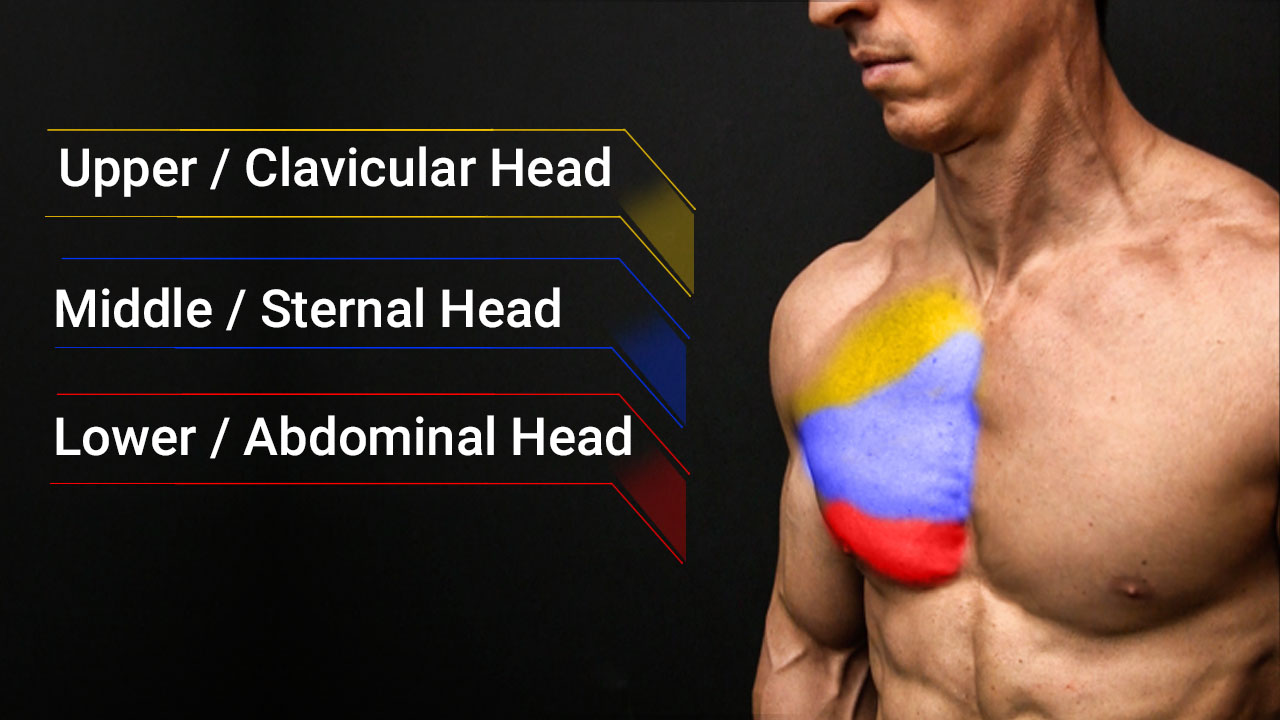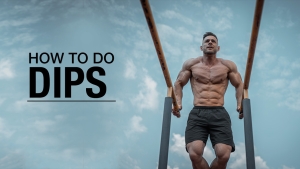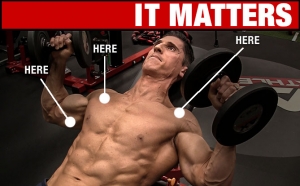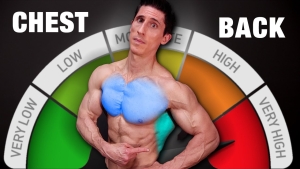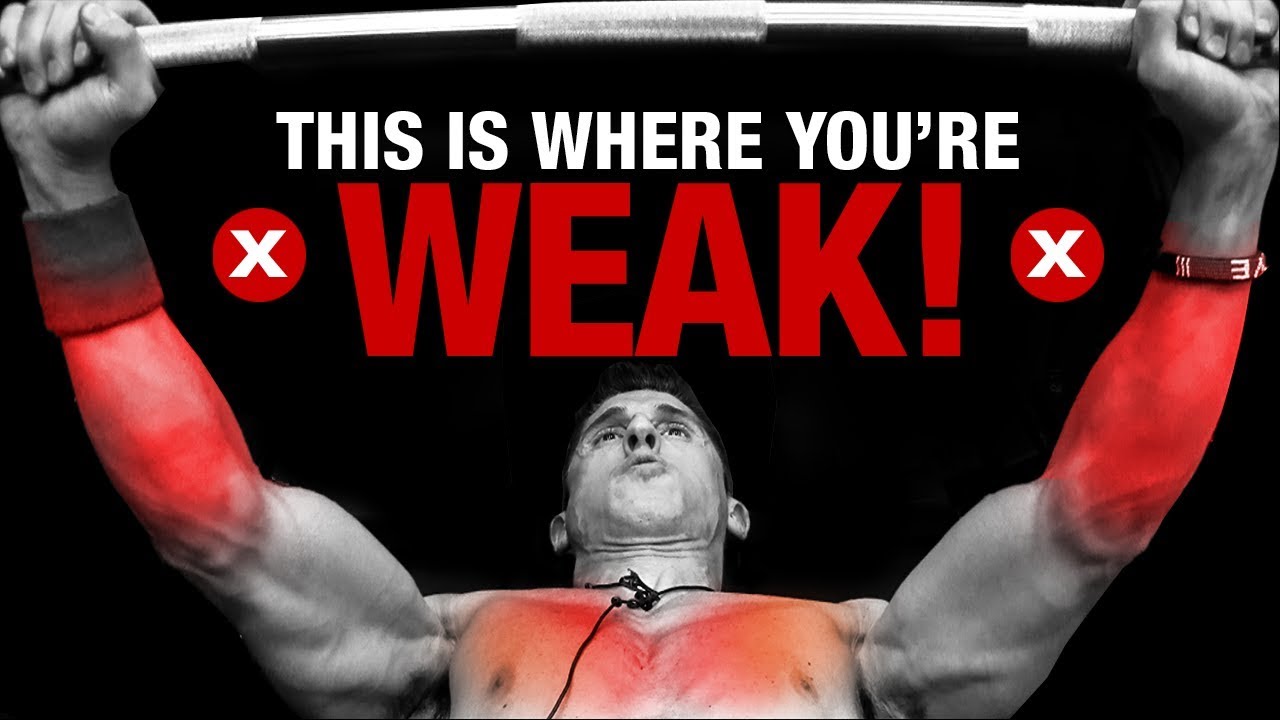
5 SIGNS OF WEAK CHEST MUSCLES
If you’re working out your chest regularly and are frustrated at your lack of chest muscle strength and appearance, you may have weak chest muscles.
But how do you know?
I’m going to share 5 tests you can use to determine if your chest muscles are the culprit.
Chest pressing motions require that the pec major, deltoids, and triceps all work cooperatively to move the weight. So, the problem could be any one of those three.
If you have one or more of these red flags, lack of chest muscle strength is likely the problem, and not your shoulders or triceps. But never fear! I can help.
What I’ll show you here will help you create a better-looking chest and overcome any upper body imbalances you may have developed over time.
YOU CAN’T TELL JUST BY LOOKING
You can’t diagnose weak chest muscles by appearance alone.
Poor posture won’t signal chest muscle weaknesses as much as it would for weak scapular and back muscles. Rounded shoulders could mean a tight chest, but not necessarily a weak chest.
Of course, you should strive for good posture, and good shoulder-back posture will absolutely improve the look of your chest. But good posture alone won’t make your chest muscles stronger.
You need a sure-fire way to isolate if chest weakness is what’s holding back your presses or your chest development.
The 5 tests I’ll show you will reveal chest muscle weaknesses very quickly, and then I’ll show you what to do to fix all of them once and for all.
WEAK CHEST SIGN #1: LEADING SHOULDERS
The first red flag occurs during a barbell or dumbbell chest press as you press away from your body.
In a properly executed bench-press, the shoulders should be pulled back and down as you’ve heard me explain before.
If your shoulders start to get out in front of the chest on every rep, especially as you start to fatigue, it’s a major red flag for weak chest muscles.

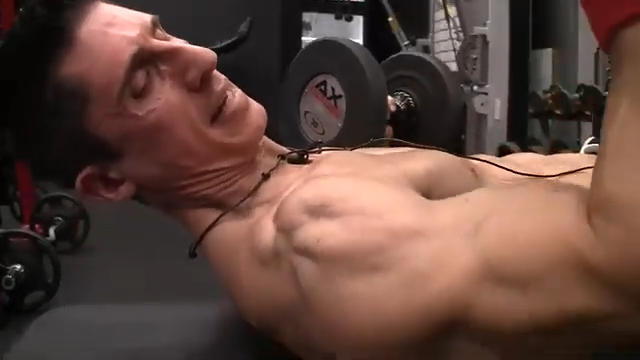
This happens because the shoulders do participate in pressing the dumbbells off your chest, especially at the bottom. But the chest is supposed to take the brunt of the load once the weight is off the chest a couple of inches and then triceps take over for the lock-out.
If you don’t have good strength in that middle range, then the shoulders will work to press the weight up.
Weak chest muscles also encourage the shoulder muscles to cheat the weight up by shortening the overall distance of the press.
The shoulders should stay back behind the chest. If your shoulders can stay back here and the chest can press away on both exercises, you’ve probably got adequate strength in your chest.
If not, we can show you something to do about it.
WEAK CHEST SIGN #2: OVERHEAD PRESS STRONGER THAN BENCH PRESS
The next major red flag we have to cover here is a discrepancy between your overhead press and bench-press.
If you can press close to your body weight on an overhead press but can’t bench press 1-½ times your body weight, your chest muscles are weak.

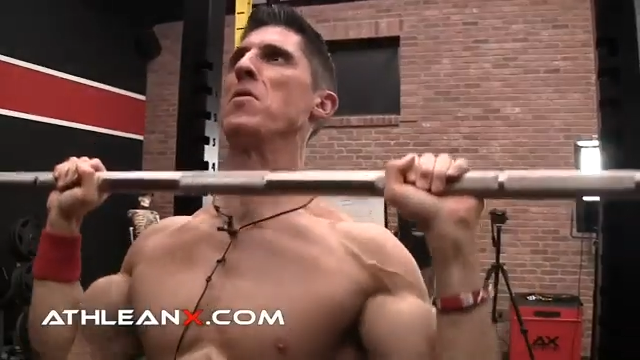
The bench press uses your shoulders, triceps, and chest to perform the lift, whereas the overhead press relies most heavily on the shoulders because of the angle of the press against gravity.
If you have an excellent overhead press and struggle with bench, then you likely don’t have shoulder weakness. The problem is your chest.
That’s Red Flag #2.
WEAK CHEST SIGN #3: BENCH FAILURE POINT
Failing the mid-range of your chest press is Red Flag #3.
When I perform a bench press rep, obviously I have to get the bar down to my chest and press it back up to the top to lock out. If you are constantly failing halfway up, it’s likely that your chest is the weakest link.

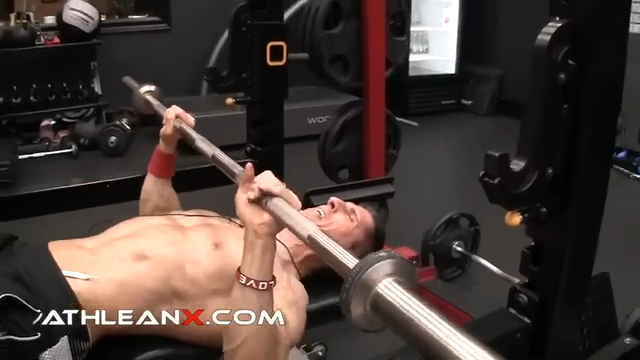
At the bottom of a press, the shoulders are in their most advantageous position to do the pushing.
I did mention in the beginning how you want to try to get the chest to help out and recruit from down there by getting the proper position, but it’s not to discredit the fact that the shoulders are going to be contributing the most off the chest.
At the very top, to get through lockout, your triceps are going to be recruited maximally. However, getting though that midrange is where the chest is going to be called upon the most and if you always fail in that middle portion of the rep then you need to start looking at your chest.
Again, I’m going to tell you exactly what to do to fix this.
Just be aware that’s a major red flag that your chest is not contributing enough.
Moving onto red flag number four, we’re dealing with the push-up again.
WEAK CHEST SIGN #4: THE 25-REP TEST
Performing 25 push-ups in a row gauges overall strength and muscle endurance.
We’re looking at your ability to not just do a push-up, but the capacity to do it continuously.
For this test, you’re going to add an additional gauge of strength. Apply what I just told you about the bench press by adding a pause-hold. Doing this will put the chest into its most vulnerable position where the movement is toughest as you attempt to execute all 25 reps.

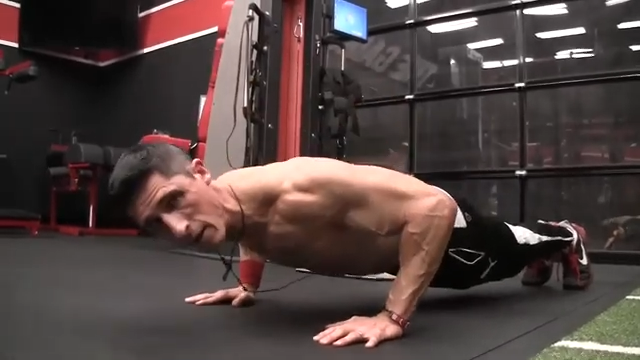
25-REP PUSH-UP CHALLENGE
- Complete 5 push-ups.
- Pause and hold for a 5-count midway down after your fifth rep.
- Complete reps 6 through 10.
- Pause and hold for a 5-count midway down after the 10th push-up.
- Repeat this sequence every 5 reps until you’ve completed 25 push-ups.
Doing 25 push-ups with 5 five-second pause-holds is not easy. You’ll feel the burn where you should feel it, in the chest muscles you’re trying to build.
If you can’t complete this challenge but are strong in lower rep ranges, it’s an indication that you’re lacking muscle endurance.
WEAK CHEST SIGN #5: UPRIGHT DIPS VS. CHEST DIPS
If upright position dips are easier for you than chest dips leaning your torso forward, you’ve got a chest weakness.
Upright position dips make the exercise easier because of all the muscles involved. Remember that all chest press movements involve the pecs, the anterior delts, and the triceps. Plus, the upright dip puts the chest in its most mechanically advantageous position.
As you angle your body forward, you shift the emphasis to the pec muscles away from the triceps.

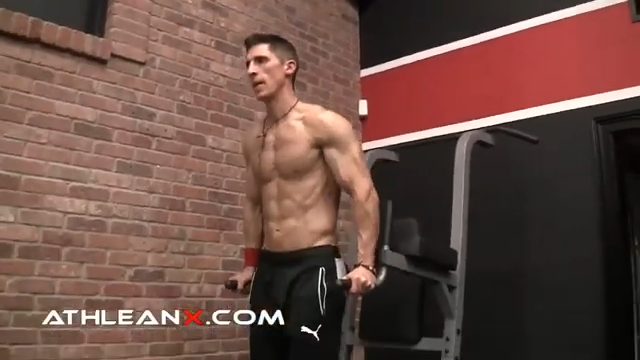
3 WEAK CHEST FIXES
Now that you’ve identified your red flags, it’s time to fix them. Here are 3 exercises you can use to do that.
Start with the dip.
WEAK CHEST FIX #1: WEIGHTED DIPS

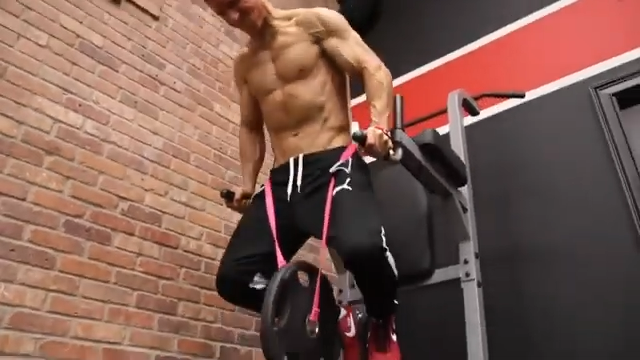
Use a weight belt with a barbell plate to overload this exercise.
Start with a barbell plate that lets you perform a few good reps. You don’t have to start with a 45 (22kg) plate. Use a lighter plate and work up. The important thing is adding resistance beyond just body weight and keeping your body in that 12 o’clock-6 o’clock attitude throughout.
It also doesn’t matter if the increased resistance means fewer reps.
Weighted dips improve your dip strength, which will carry over to other exercises and address chest weakness. Remember to train these in the correct chest dip position.
WEAK CHEST FIX #2: MID-RANGE BENCH PRESSES
As we discussed earlier, if your shoulders have that tendency to start to drift in front during a chest press, or if you get stuck midway up, the partial bench press is for you.
The Mid-range Bench Press will help fix those weaknesses.
Add partial reps to your full range of motion repetitions, and then do some additional partials as some extra work to address your weakness.

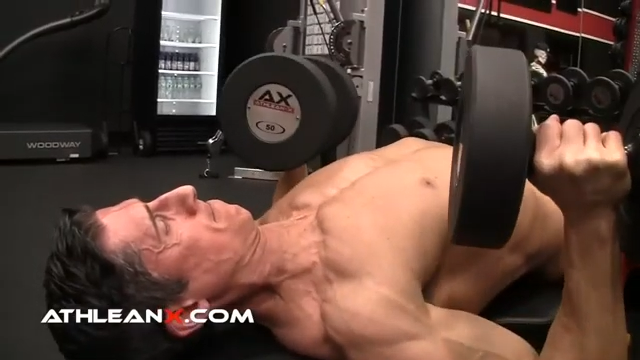
Make sure you’re holding your shoulders back so that your chest sticks out, regardless of what type of weight you’re using: dumbbells, barbells, or chest press machines.
You can then introduce some pause reps. Stop and hold the weight in the middle part of the range of motion before pressing the rest of the way up.

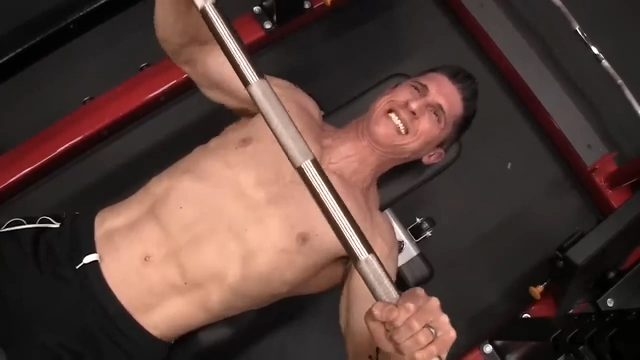
Paused reps don’t always have to be on your chest when you initiate the pause. The weight can hover inches above your body.
WEAK CHEST FIX #3: CABLE CROSSOVERS
Cable Crossovers are a great way to isolate the chest and take the chest muscles through their full range of motion.
Cables facilitate this better than any other type of exercise because the arm can be moved into full adduction, crossing the midline of your body. A primary function of the pec major muscles is to adduct the arm.

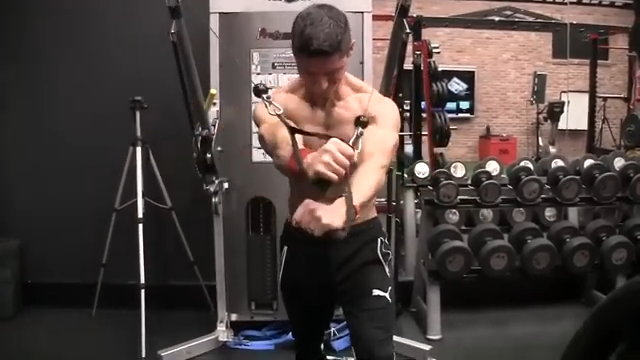
You can do these as heavy as you like. Just make sure you’re using a full range of motion.
Adding these single-sided crossovers to your chest workout lets you concentrate on each side, which is important because none of us is equally strong on both sides. Plus, there’s a phenomenon called bilateral deficit, which means that you’ll be able to exert more with a single side than with both left and right sides combined.


You’ve got to make sure you’re overcoming the weaknesses that you have. Getting stronger begins by identifying weaknesses.
When you train like an athlete everything matters; finding weaknesses and fixing them is what athletes do.
For a comprehensive strategy aimed at enhancing lean muscle and strength throughout your body, explore our ATHLEAN-X programs. Pick the one that aligns best with your goals and available equipment.

- Weak chest muscles can be frustrating and difficult to diagnose. The symptoms vary and deficient chest muscles affect the way the entire body looks.
- You can’t tell if chest muscles are weak simply by looking at them, like you often can with shoulder or back muscle weakness. Weak muscles don’t necessarily mean underdeveloped muscles.
- We shared 5 tests you can do on your own that can help you determine if weak chest muscles are what’s holding back your bench press, or why your chest muscles appear under-developed.
- You can perform these tests during a chest workout, or on a separate day.
- The 5 symptoms of weak chest muscles are (1) shoulders leading the way during a chest press, (2) an overhead press that’s far stronger than your chest press, (3) your bench press “sticks” a few inches off your chest, (4) you’re unable to perform 25 push-ups with pause-holds, and (5) you can do an upright dip with no problem but struggle when you lean forward.
- Once you figure out if your chest muscles are in fact weak, there are 3 things you can do to address it.
- First of all, make sure your form is good on presses. Hold your shoulders back and down during chest press movements.
- Train the chest muscles in their weak areas by adding resistance such as the weighted dip, performing partial reps and paused reps, and chest isolation exercises like single and two-arm cable crossovers.
WEAK CHEST MUSCLES FAQ
Strengthen a weak chest by performing resistance exercises, especially by isolating weaknesses and training those.
Doing mid-range reps and pause-holds using moderately heavy weights is one method to strengthen it.
It’s important to make sure that your biomechanics are correct to put the chest muscles in a position where they can work properly. Holding shoulders back and down during chest presses is important for that reason.
Strong chest muscles are important to overall shoulder health and protect against shoulder joint disorders.
It’s possible to see strength gains in as few as two weeks. If you apply progressive overload and are working the weak areas such as the mid-range in a chest press, a realistic time frame would be a month to six weeks.
Other factors can affect strength such as nutrition, amount of sleep, time of day, underlying injuries. All things being equal, you should be seeing gains within just a few weeks if you’re working the muscles in the right way.
Build a strong chest by performing resistance exercises that require the chest muscles to work. Exercise that isolates the pectoralis major muscle, combined with compound movements that require the surrounding muscles to work, have been proven to build a strong chest.
Barbell and dumbbell presses, and cable crossover exercises are some of the most popular exercises for developing the chest.
If you’re performing an exercise that’s proven to build chest muscle, and are performing it correctly, chances are that your genetics are to blame. In particular, people with long arms and relatively narrow collar bones will have a difficult time building chest muscles.
Another reason may simply be that you’re not working your chest hard enough. Clinical research shows that for muscle protein synthesis to occur, a muscle must be placed under mechanical tension significant enough to induce growth.
If every rep and set is easy, if your last rep looks and feels like your first, you’re probably not working hard enough.
Chest muscle weakness will not cause pain, but it can cause pain in the shoulder joint and shoulder muscles due to compensatory stress. The anterior deltoids–an accessory muscle during chest exercise–can become overworked if the chest muscles (pectoralis major muscles) do not bear their fair share of the load.
Pain in a chest muscle could signal something as minor as muscle soreness following strenuous exercise. Soreness and pain are different. Real pain in a chest muscle might be a symptom of muscle or tendon damage.
Deep chest pain accompanied by shortness of breath, left-side pain, or jaw pain may be symptoms of a serious condition like congestive heart failure (heart attack). Consult a healthcare professional if you show these classic symptoms of heart failure.
If you do experience pain in your chest muscles or shoulder joint, rest the area by taking a few days’ rest, and icing the area. Pain relievers like nonsteroidal anti-inflammatories are fine too. Be conscious that pain can be your friend because it signals underlying symptoms like tendinitis. Pain relievers can lead you to believe that an injury is healed before it actually has.
If you do have an overuse injury like tendinitis (aka tendinosis), make sure to warm up thoroughly before your chest workout to flush the local body tissues with blood. You may find that a good warm-up alone can alleviate pain, and you never want to start working out with cold muscles in any case.

Jeff Cavaliere M.S.P.T, CSCS
Jeff Cavaliere is a Physical Therapist, Strength Coach and creator of the ATHLEAN-X Training Programs and ATHLEAN-Rx Supplements. He has a Masters in Physical Therapy (MSPT) and has worked as Head Physical Therapist for the New York Mets, as well as training many elite professional athletes in Major League Baseball, NFL, MMA and professional wrestling. His programs produce “next level” achievements in muscle size, strength and performance for professional athletes and anyone looking to build a muscular athletic physique.
















